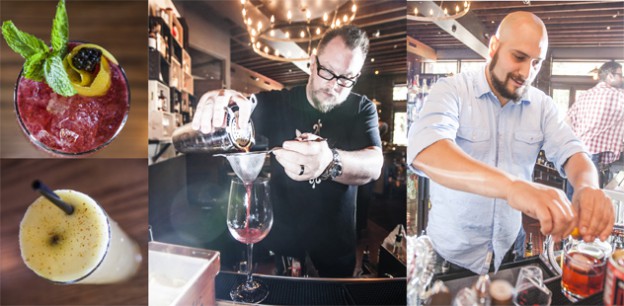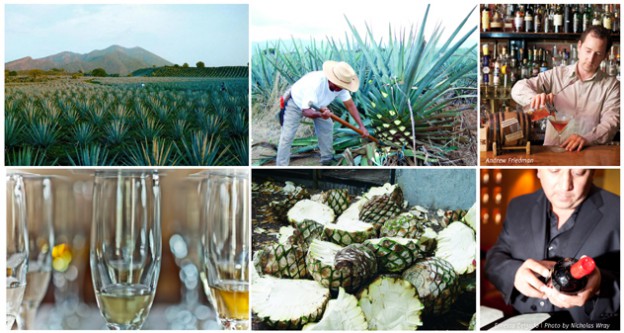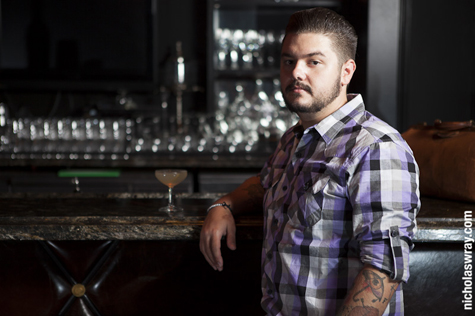The Red Rabbit Kitchen & Bar is one of the driving forces behind Sacramento’s rise to craft-cocktail prominence
When Imbibe magazine listed Sacramento as one of the top 10 “places to visit in 2013” because of its surging craft-cocktail culture, it seemed as if by some divine alchemy the local drink scene finally made it onto the radar of cocktail enthusiasts on a national level.
At the crux of the movement promoting the local hand-crafted dram is The Red Rabbit Kitchen and Bar, where you’ll only find cocktails created from the ground up—homemade syrups, freshly squeezed juices and ingredients like fresh, hand-muddled herbs join the party in the glass.
“This year we’ve had a lot of national, and some international, focus on Sacramento as being a legitimate cocktail town,” says Matthew Nurge, one of the restaurant’s partners. “To be mentioned now in the same conversation as Portland, as Seattle, as New York and San Francisco is awesome.”
When longtime friends Nurge and Sonny Mayugba (chef John Bays is also a part owner) opened the doors to their hare-themed restaurant in February 2012, their vision was simple: to create a chill environment where cocktail nerds and neophytes alike could luxuriate in high-quality food and drink.
“The whole idea behind this restaurant is we wanted to do kind of a sexy upscale atmosphere, but we really wanted the attitude to be casual and easy and simple,” Nurge says. “So the whole idea between both the food program and the bar program is that we come up with simple, delicious, affordable food and beverage. We want to be a neighborhood craft bar, our motto is ‘Raising the Neighborhood Bar,’ so we wanted to have the same casual vibe of a neighborhood joint with some good stuff—good food and drink.”
A sentiment embraced by the cheerful and enthusiastic staff behind the bar.
“We work really hard to make sure that everyone who comes in here feels welcome. There’s a complete lack of pretension that’s in here,” says Christopher Sinclair, Red Rabbit bartender and president of the Sacramento Bartenders Guild. “It sort of oozes out of the walls. I mean from the way that we talk to each other to the way we talk to our customers.”
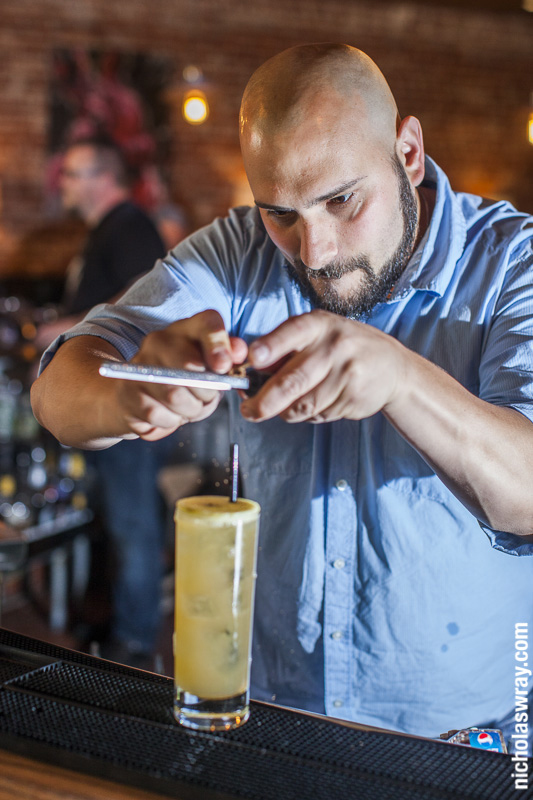
Christopher Sinclair
Much like the “farm-to-fork” movement that’s filled the bellies of local foodies, a burgeoning “farm-to-glass” campaign is starting to resonate with those looking to get their quaff on.
“People see beverages the same way they see food,” Nurge says. “They want great chefs using great products and making them great food, [and] they want great bartenders using great products to make great drinks.”
Nurge, a Sacramento native and self-professed “cocktail nerd” cut his teeth in the bar business as a youngster hanging out with his mother while she tended bar at Joe Marty’s on Broadway, but perfected his skills as a mixologist at R15 and The Shady Lady Saloon.
Boasting an eclectic roster of spirits, the cocktail menu is a throwback to the fine art of cocktail-making that was the hallmark of the pre-prohibition era.
“Some of them are from old recipes dating back to the 1800s and some of them are kind of modern twists on some of those,” Nurge says. “It’s kind of an amalgamation of that, some are mine, some are stolen, some were lost to history.”
Nurge credits partner Mayugba, yes, the same Mayugba that put out the seditious zine Heckler back in the day, as the “super-connector” for bringing together a brilliant cast of restaurant and bar industry talents—including longtime chef John Bays, who honed his culinary chops in the kitchens of heavy-hitting restaurants like Mulvaney’s B&L, Morton’s and Rio City Cafe.
“I’ve never known anyone in my life who can get things done as easily as he can, he just says things and makes them so,” Nurge gushes about Mayugba. “There’s almost something magical about it, he puts it out there and it just happens. So, Sonny put us together, basically.”
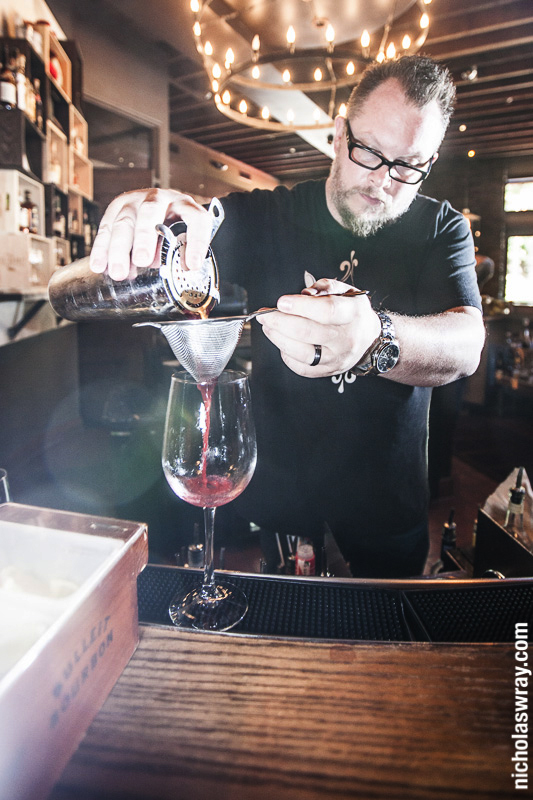
Matthew Nurge
The cocktail menu is an exercise in restraint—you won’t find an encyclopedia-sized treatise of offerings—mixed with cheeky nods to social movements (Harvey Milk punch), historical references (Krakow salt mine) and literature, like the trio of tastings inspired by Chuck Palahniuk’s Fight Club.
“First rule of ‘flight club’ is you don’t talk about it,” Nurge jokes. “The ‘flight club’ is just a simple idea I had to help introduce people to things that maybe they haven’t tried before. It’s an affordable way to try new things or to try things that you already love. The price is ridiculously low. I mean it’s $15 for three tastes and some of the stuff you might get in there is $15 a pour on its own. It’s a fun way to get people to try new stuff; that was my intention, anyway.”
Nurge adds that bartender culture also served as inspiration for one of the libations on the Red Rabbit menu.
“With the ‘buck hunter,’ the style of cocktail is a buck (a class of cocktail that mixes ginger beer or ginger ale with citrus and spirits) and Buck Hunter is a video game that bartenders like to play,” Nurge says. “For whatever reason, I don’t know why [Buck Hunter], somehow became synonymous with bartenders.”
With Midtown Cocktail Week quickly approaching, another reason for the nod to the local liquid culture by the editors of Imbibe, Nurge and the rest of the Red Rabbit contingent are planning a bevy of activities surrounding the fete. From a competition that takes its inspiration from the three-legged races of family reunions and picnics, involving a suit in which two bartenders will literally be attached at the hip, to a pop-up event demonstrating the talents of its drink-slinging employees, the Red Rabbit is gearing up for the alcohol-infused festivities.
“On Sunday, Aug. 25, 2013, we have an event called ‘Best in Show,’” Nurge says. “We’re the last event, and the last event tends to be kind of what we’ve dubbed the closing party. It’s sponsored by Maker’s Mark, and we’re doing a blue ribbon county fair meets pig roast event, so we’ll have carnival games and prizes and a nice, big, fat pig roasting in a box.”
At the core of the Red Rabbit’s bar program is a dedication to quality ingredients, but it’s the partners’ belief in, and commitment to, the ideals surrounding the locavore movement that extends beyond the bar and spills out onto just about every facet of its business model that makes it so distinctive.
“We have a program, the employee incentive program; not that anyone’s made too many dollars from it, but every employee here is actually a part owner,” Nurge explains. “So the employees collectively own five percent [of the business].”
The partners are looking to expand the reach of the hare; Nurge alludes to a possible expansion effort into “The Kay” district and hints at even breaking with a few craft-cocktail traditions when Sinclair suggests the addition of milkshakes to the menu.
“That means we need a blender,” Nurge retorts. “I’ve been on a no blender rule for like eight years. When the whole cocktail resurgence started, everyone who thought they knew something, thought they knew everything, so all of a sudden there were all of these new rules. You know, like no one makes Long Islands, no one carries Jägermeister, no one has a blender, no one carries Red Bull or blue Curaçao.”
“Jäger’s actually great. Bros don’t shoot it anymore,” Sinclair chides. “Fireball took over, so now it’s socially acceptable to drink Jäger.”
After surviving a year in one of the toughest businesses to break through in, as well as a nasty smear campaign by a disgruntled Yelper, the Red Rabbit endeavors to follow in the footsteps of its block mates, notably, Harlow’s and Centro.
“I think we just have a rad concept. We have good product, at what I believe is a good value, and we have good people that work for us,” Nurge says. “That’s a big key to the success of this business.”
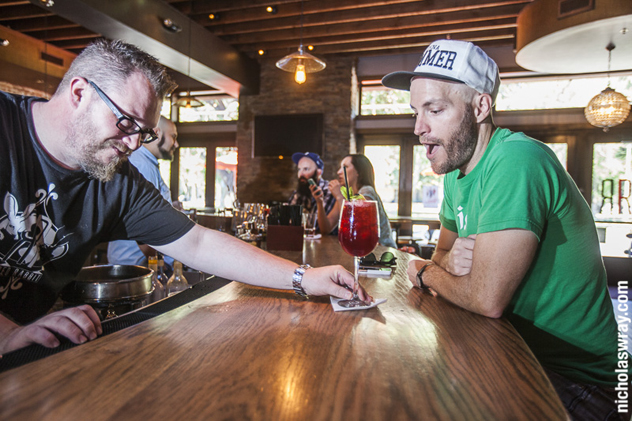
Nurturing the talent in its ranks, while looking to spread the gospel of the Sacramento craft-cocktail scene, Nurge is thrilled by, and, most importantly, supports his employees’ desire to travel the world in search of inspiration—from competitions in Chicago to Puerto Rico.
“I get to meet awesome bartenders and see what they’re doing outside of just our little bubble,” Sinclair says. “It also allows me to spread the good word that is Sacramento and get people really, really excited about coming here and getting excited about seeing this place and bring sort of the appreciation the city deserves, as well as this restaurant.”
The philosophy of craft doctrine also appears to be spilling out into the corporate market—with franchises like Disney and Applebee’s serving up their own craft-inspired cocktails on their respective menus. The movement looks like it’s gaining some serious mainstream credence.
“That’s why T.G.I. Friday’s has craft cocktails on their menu now,” Nurge explains. “It’s everywhere, it’s spreading, but in a good way. It’s a pain in the ass—just ask Carlos over there—to juice for five hours a day, but the end result in the product is irreplaceable.”
Best in Show, The Red Rabbit’s official Midtown Cocktail Week event, will take place from 1 to 4 p.m. on Aug. 25. Admission is free. For a full list of MCW events, go to Midtowncocktailweek.org.
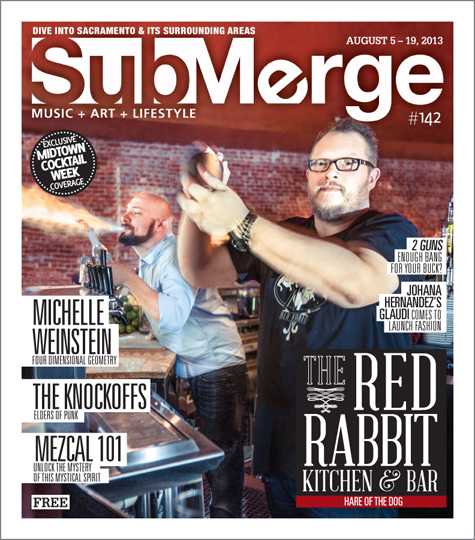
Ernesto Delgado and Andrew Friedman gear up for a mezcal seminar and tasting event at Mayahuel for Midtown Cocktail Week
Look, when the Spanish conquistadors rampaged through the tribes of North America in the 16th century, there were long-lasting and devastating consequences. While they might have brought with them oppression, disease, chaos and Catholicism, they also brought a bit of knowledge—specifically knowledge about distilling spirits in copper stills. This is not to say the population of the Americas was dry and sober before their “discovery”; the Aztecs were already drinking by the time the Spanish arrived, but the alcohol content of pulque, their agave beverage of choice, is equivalent to a blonde beer.
While that might have been socially acceptable for the Aztecs, it was not going to cut it for an army of Spaniards who had just crossed the Pacific, murdered anyone in their path, and suddenly run out of hard booze. So, using the agave plant as their fruit, they developed a technique that would yield agave juice with a higher sugar content, and then distilled it according to western practices.
The result? Mezcal, a spirit now fundamental to the Oaxaca region of Mexico. For natives, Mexicans, Mexican-Americans and liquor connoisseurs alike, mezcal is the enigmatic beverage that embodies both a certain degree of authenticity and a particular taste. As Ernesto Delgado, owner of Mayahuel, said in a brief conversation and mezcal tasting, “The Spaniards perfected the process started by the Aztecs.” It’s been centuries since this beverage was discovered, created; yet, even today, mezcal is a complicated, sophisticated, emergent spirit that we can expect to hear more about in the coming years. On Aug. 24, 2013, the Sacramento Bartenders’ Guild will bring a series of informative seminars and tastings to Mayahuel as part of Midtown Cocktail Week, where mezcal will be the featured spirit of the day.
So what exactly makes mezcal so unique? Andrew Friedman, co-chair of the education committee for the U.S. Bartenders Guild and one of the organizers for the mezcal event, has a simple answer: “Mezcal means, in translation, juice of the agave. While all tequilas are mezcals, not all mezcals are tequila. Even pulque is mezcal.” In essence it comes down to the type of agave that is used to distil the spirit, and tequila uses only the blue agave, or blue webber, where mezcal can use any one of 28 different agaves to produce its mash—the combination of water and soon-to-be fermented substance.
Charles Connolly, bartender at Mayahuel concurs. “Just like wine has different grapes, Mezcal has different agaves.”
There’s a lot to mezcal, almost too much. Explaining why he is looking forward to the seminars, speakers and producers at the upcoming event, Connolly nods, “There’s still so much for me to learn.”
Friedman, who also bartends at Liberty Bar in Seattle, is eager to spread the mezcal love. “Because so many people don’t know about mezcal,” he says, “we really just wanted to make it about the spirit itself.” Each of the experts we spoke with agreed that mezcal is part of the culture of Oaxaca. The production process itself speaks to the time-honored tradition of hand-crafted distilling and contemporary mezcalarias.
Once the agave plants have been cut down to a piña with a cöa—a large spade like tool with round edges—they are then roasted in the ground in a three- to five-day process. In a large dug-out pit lined with stone, acrid wood is burned to ash which is then topped with the piñas, or agave hearts. This is then covered with leaves and dirt and left for the better part of a week.
According to Friedman, this gets “the phenols to attach themselves to the agave hearts. They caramelize and get a rich flavor.” From here the hearts are turned into mash and distilled; then they’re ready to be served as mezcal. Unlike most quality liquors, however, mezcal is generally served joven, or not aged. This means that each experience with a new brand is raw, rampageous, and real.
“After drinking whiskey for years,” explains Friedman, “I tasted mezcal and something just clicked. Every mezcal you taste is going to be different. Agave takes eight to 25 years to grow, so each different batch is going to have different yeasts, a different flavor profile. Mezcal changes every year, with every batch.”
There’s a refined experience bottled up in this fiery drink, which explains Friedman’s transition from fine whiskeys to mezcal. The taste of mezcal is full of heat, smoke, earth, burn. Much like a good whiskey burns warm, down the esophagus and into the chest, a good mezcal pokes at the tongue delicately and almost seems to sear the back of one’s throat in the best, most unique way possible.
“The flavors are very earthy,” says Friedman. “Like wine, people describe a—this might sound strange—but a new tire taste, a little iodine. My first experience was with Topila, a very small agave. It only grows in the wild, usually on rocky soil. It was a rich almost rubbery flavor, but great.” The experience Friedman is describing here is this difficult hybrid of taste and feeling, the flavor and the bodily reaction to the alcohol itself.
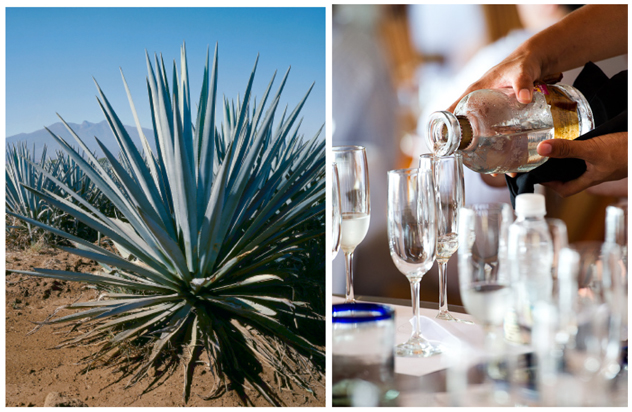
As such, Friedman notes that this experience isn’t for all drinkers. “Not everyone who likes tequila is going to like mezcal,” he details. “Just like whiskeys, scotches and bourbons, people like the different nuances, the less sweet, the more spicy. The same thing is happening with mezcal. It’s definitely a return to the artisanal. Also it’s a lot more expensive. The average cost of a bottle of mescal is about $45.”
To accentuate that high-end pricing, there’s also a spiritual side to mezcal. Folklore has it that drinking mezcal can produce a supernatural experience, a trip, a rite of passage, a hallucinogenic stumble down the pathways of your being. Freidman, having visited Oaxaca recently to see the production side of mezcal, saw first hand how locals hooked a turkey breast and placed it in the still, “so the boiling vapors will pass thankfully over the meat.” This traditional spirit drink is for special occasions, but nonetheless it’s an ingrained part of the community.
Describing how mezcal works on the mind and body after a prolonged sipping, Friedman imtimates, “it’s very low and very calm. You feel very connected, quiet.”
Ernesto Delgado, eager to show off his mezcalaria and increase the Sacramento’s awareness of this fine fermentation, agrees. “Mezcal is more artisanal. It’s made in small batches; it’s familial. It’s just uplifting, too intense to shoot.”
While speaking with us, Delgado happily pulled a few choice bottles off of his colorful Oaxaca-inspired shelves to try. We sipped three different producers: Pierde Almas Joven, San Juan Alipus, and El Tinieblo Joven. The Pierde Almas, our second favorite, burned on the tip of the tongue with a direct, aggressive flavor. The San Juan Alipus had the richest profile—a fruity scent, smoky, with a light burn that lingered on the back of the tongue, traveling down the back of the throat. This combination seems right for enjoying over a conversation with longstanding friends. Finally the El Tinieblo had a hot heat, a direct flavor that warmed the chest but felt most like a metal still in its bluntness. Unsurprisingly, as we had been told by mezcal enthusiasts, none of these different brands could be mistaken for the other despite their similarities.
So, whether you’re a longtime tequila drinker, a whiskey enthusiast, a native of the Americas, or a mild mannered magazine reader, feel free to visit Mayahuel on Aug. 24, 2013 during Midtown Cocktail Week for an introduction to mezcal. The bartenders and mixologists are already playing with this unique and nuanced distillation, and, as Andrew Freidman describes it, “It really is just a class for booze nerds.” Go on, geek out on the agave.
Mezcal: A Love Story, Mayahuel’s mezcal seminar and tasting event, will take place Aug. 24, 2012. Doors will open at noon with the seminar lasting from 12:30 to 2 p.m. A large brand tasting will begin after lunch from 4 to 7 p.m. Mayahuel is located at 1200 K Street in Sacramento. For ticket information, call (916) 441-7200.
Bartender Andrew Calisterio on why Sacramento should be proud to be a “cow town”
Words by Anthony Giannotti
Sacramento has been labeled by many in larger metropolitan areas in California as a “cow town.” While this may or may not be true on many levels, the fact that we are surrounded by some of the best and richest farmland in the country is undeniable. Andrew Calisterio, bartender at Grange Restaurant and Bar, thinks we should embrace this “cow town” label.
“I grew up in rural Elk Grove before the whole tract home thing,” he says. “We had cows in my back yard. My family always had a garden and fresh food. Farm to table has always been a part of my life.” Growing up with a garden has definitely helped him know exactly what to do with the amazing produce we have around here. Calisterio continues, “We have tons of fresh ingredients. Look at all the citrus here. Don’t just put it on the side of the glass to make it look pretty, put booze in it and shake it up!”
Not only has Calisterio devoted his life to Sacramento and the fine local produce, but he is a big advocate of knowing what to do with it. He is one of the founding members of the Sacramento chapter of the U.S. Bartenders’ Guild–a national organization “of beverage service professionals dedicated to the continued refinement of [their] craft,” according to a mission statement on the USBG website. Calisterio makes no illusions of how important he thinks keeping up and furthering industry people’s knowledge is, “The education is what helps create and expand our creativity.”
It’s not just cocktails and shakers for Calisterio. He is also one of the key members in the resurrection of the Sacramento brewery Ruhstaller. “Ruhstaller was a brewery in Sacramento 130 years ago, started by Captain Frank Ruhstaller. I get to sell a really good beer to people in the industry, my friends.”
I got to catch up with the local advocate over a glass of whiskey, which of course he blended, to talk more about Sacramento and cocktails.
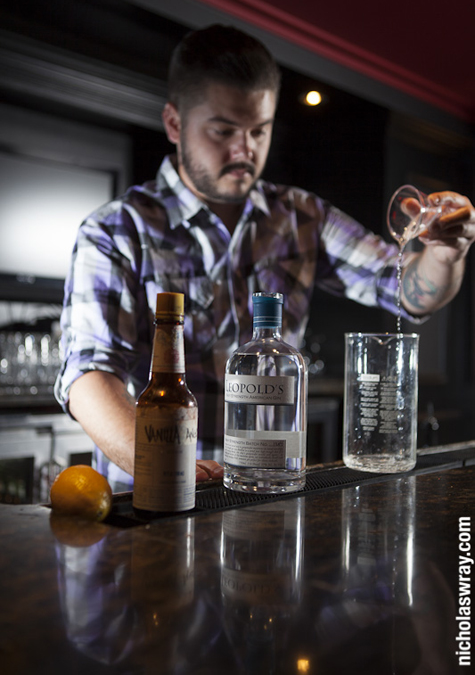
How did you start bartending?
I started this whole thing with coffee. I really enjoyed making things. I was 16 working at Starbucks. I liked making the things they had set for us, but I always wanted to make something different, something special. The guests wanted the same thing every single day, and to me that was just insane. I would try to work something in that was around what they liked, but pulling them toward something new or different. Eventually I got picked up by Java City, worked my way up the ladder there and came to a point where I could do anything I wanted with coffee. I really wanted to get into spirits. I’ve always been a fan of nice food and cocktails and experiencing flavors. I pride myself on having a good palate.
How did you start at Grange?
I went in applying for a bartending position, and they looked at me like I was crazy because I had no experience. So I asked what was available and they let me be a bus boy. There was no bar-back program there, so I would go behind the bar every chance I could to help, polish glassware, anything I could do to get in. I’d ask way too many questions and bother Ryan Seng, interrupt his conversations with guests to find out what he was doing and how he made that drink. I basically declared myself a bar-back position. One day a bartender didn’t show up. Since I knew how to make all the drinks–I even had two of my own drinks on the menu, and I was familiar with our wine list–I finally got to start bartending.
Grange is known for its affiliation with the slow food movement. Do you try to incorporate any of those principles into your cocktails?
Absolutely. I grew up in rural Elk Grove on four acres. I was in FFA [Future Farmers of America] as a kid, which ended up being beneficial for me when applying at Grange because I had this agricultural background. I knew the farmers that the food at Grange was coming from. When it came to building my cocktails, I wanted to represent the local Sacramento area.
You recently won a couple of cocktail contests. Can you tell us about that?
The big one was put on by Hangar One Vodka. It was a California-wide cocktail competition. I was already familiar with the brand because it is a farm to bottle spirit–right up my alley. A rep came in to ask me to join the competition but said they weren’t stopping in Sacramento. They were going to be in different major cities around California–Los Angeles, San Francisco, San Jose. I was a little offended that they weren’t going to be representing the capital city of California, where so much of California’s produce and agriculture comes from. So I came up with my cocktail and started networking, using social media to let my friends and peers know what I was working on and trying to represent Sacramento.
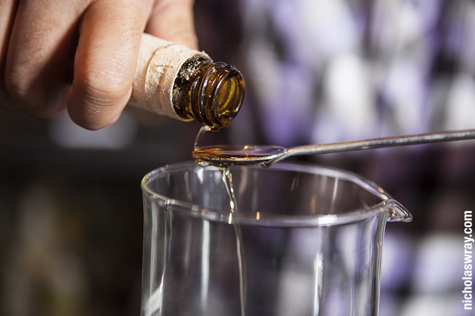
You are one of the co-founders of the Sacramento Bartenders’ Guild. What is that and what do you guys do?
As bartenders, we go visit other bars or bartenders that we respect and like to see what they are doing and learn from them. It started as this kind of informal gathering and eventually some of us decided to get together and make it formal and official. We wanted the education of bartending to be brought forward. It’s $100 a year, and if you go to just a couple meetings, you’ve already gotten your money back in products and education. We have tastings and training with brands that share their products but also teach us about spirits and what the differences are and help us learn how to use them to our best ability. We are using our connections to gather and share brands and ideas with our coworkers in town. Bar owners and workers get a chance to meet, so whether someone is looking for a job or needs a bartender, it’s just a great way to communicate. All of us are career bartenders, not just some guy who pours shots. We are trying to raise the bar around Sacramento. We have a great cocktail scene here; we just want to always see more out of it and let it shine.
So you think it’s important for bartenders to have extra education, to be able to do more than just give a shot or a beer?
Well even with that, there is a proper shot and a beer pairing, it has value. Sometimes you don’t want a cocktail. Sometimes you just want a shot or a beer. Dickel is a whiskey brand that has become really popular as a shot. Someone decided that that was a good shot to pair with a beer. And the beers aren’t Budweiser anymore. North Coast Company Blue Star is the inexpensive beer on tap now. So the bar is being raised even for just a shot and a beer. Having a vast knowledge of spirits and cocktail ingredients helps you to attract more guests and give them that experience they are looking for when they go out to eat or have a drink. I love when someone comes in and says “Make me something.” My next question is what do you usually like? And I will try to avoid that.
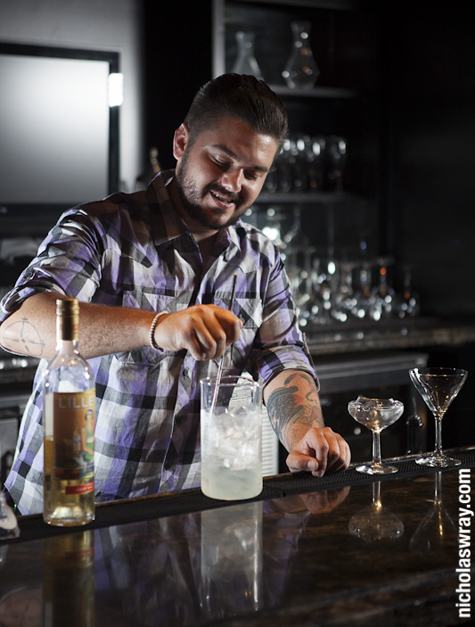
You’re not just a cocktail guy. You are also involved with Ruhstaller Beer…
I was brought on early with this company. I am honored to be able to help with the resurrection of the old Sacramento brand… They asked me to help build the brand because they know I am a social guy. I lug around kegs and talk to people and help with sales. I’m doing the same thing I do every day, but on the other side of the bar. I’m getting the bartenders to try this beer, telling them how good it is and then they buy it for their bars. The company has grown a lot and I help when I can, mostly with social networking or helping pour at events.
Do you ever try to combine your knowledge of beer and cocktails to make a beer cocktail?
For beer week, we had a beer pairing dinner at Grange with some big names from Sacramento. I put together a cocktail that was in the fashion of a shot and a beer, with a twist. I took [Ruhstaller] 1881 and made syrup out of it and made an Old Fashioned using Woodford Reserve. I even used local Sacramento oranges in it. I served it with a shot of beer on the side to help represent the beer. Darell Corti [gourmand and co-owner of Corti Brothers] said it was the best aperitif he’d had in Sacramento. I was so happy, I couldn’t stop smiling. It was a great boost.
What’s involved in a great cocktail?
Balance, first and foremost. I try to balance where the flavors hit on your palate. I generally start with a great spirit or an end result flavor. Or I try to pick out flavors that will work well in the cocktail and pair with the food. Sometimes it’s hard when I really like a certain spirit that has so much great flavor on its own because I’d rather just drink it neat.
Midtown Cocktail Week is coming up. What sort of blowout is Grange doing this year?
Blowout is a good word. Last year was such a success that it was too busy to accommodate everyone in the hall. So this year we will be using the dining room. Grange’s dinner service will come to a screeching halt and be replaced with amazing cocktails and appetizers. The band The Silent Comedy will play. The theme this year is Sacramento, so a little politically driven. At Grange, we are doing the anti-prohibition act. We want people to come out and vote for the cocktails. We are also going to have hometown hero Jayson Wilde come back and guest bartend the event.
Is there anything you’d like to see out of the Sacramento food and cocktail scene?
Sacramento has had a lot of successful people start here and make names for themselves, but they always end up leaving. It’s great when they come back around and visit, but Sacramento needs some talent to stick around. If Sacramento is going to grow or be more successful, we need these people to stay and be a part of this city. I would like to see some of the people from Sacramento that have been successful elsewhere be successful in Sacramento. I enjoy other cities and traveling, but this is my home. I have a lot of friends and inspiration here. We are the capital city in the largest state.
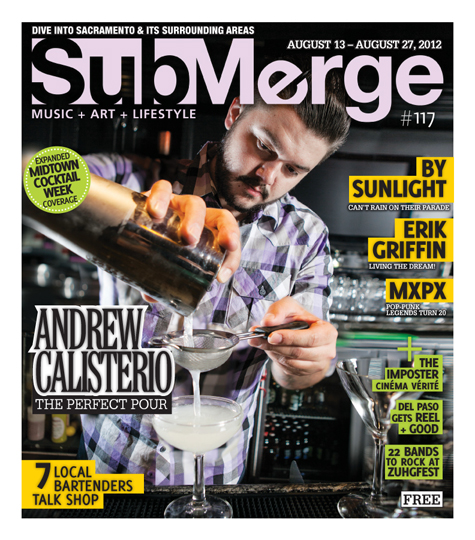
Midtown Cocktail Week will take place at various venues from Aug. 19 through 26, 2012. See what Andrew Calisterio comes up with at the “Repeal Prohibition – High Styled 1920’s Political Rally” event at Grange on Aug. 24, 2012. The event will run from 5 p.m. to midnight. To keep track of other Cocktail Week happenings, go to http://midtowncocktailweek.org/.

